Gujarat’s tryst with water gave us a magnificent heritage, writes Malti Gaekwad
Rainwater harvesting seems to be a fairly new term and every year before the monsoon we start seeing advertisements and hoardings to advocate collection of rainwater. While the awareness of rainwater harvesting seems like a new fad in the face of growing shortage of drying rivers and portable water due to environmental imbalance Gujarat has for many many centuries had a shortage of water. On one side it is the state in India having the largest coastline and is surrounded by sea water on three sides, while the flip side is the high degree of saltwater ingress…. The seepage of salt in the groundwater levels has always left Gujarat asking for more drinking water.
The state of Gujarat is dotted with over 500 big and small step wells. The origins of these step wells may be traced to reservoirs in the ancient cities of the Indus Valley civilization such as Dholavira and Mohenjo-daro. Most of these step wells which were constructed centuries ago, are wonderful examples of technology, art and architecture. The purpose of the step well was to recharge the groundwater, collect rain water and supply it in times of drought. Intriguing features of the step wells are: the sun rays do not directly reach the water surface, so evaporation is controlled, plus water remains fresh due to the natural floor. Also they were constructed in a way that they can resist 7.6 Ricther scale earthquakes !
Many dynasties such as the Chavdas, Solankis, Vaghelas as well as the Jain merchants funded innumerable temples, lakes and stepped wells and embellished them magnificently with sculptures and carvings. Throughout the centuries due to this patronage a distinct style of architecture developed early in the state. Among the 100s of small and large temples of Gujarat, those built by the Solankis, (also known as Chaulukyas) are more prominent than others.
The first king of the Solankis Mula Raja (942 to 997 AD.) defeated the Chavdas and founded his Kingdom in uphill Pataka, the modern day city of Patan in North Gujarat. Mula Raja’s descendants Samundra Raja, Dularva Raja, Bheemdeva 1, Karnadeva, Siddh Raja Jayasimha and Kumar Pala built many temples and excavated large reservoirs. Almost all major towns have their own step wells. The smaller wells are called VAVDI. The monuments were built over various centuries and not specific to any religious or ethnic groups. Hindu, Muslim and even Jain rulers, all patronised these construction activities for their communities.
Architecture and stone carving developed greatly in Gujarat from early times. The most famous among them is the temple at Modhera built by Bheemdeva I. Other important architectural monuments include Rani Ki Vav, Sahstraling, (meaning thousand lingas) reservoir at Patan. Rudra Mahalay at Siddhpur and the Shiva temple at Somnath on the western shore. Apart from these, the Solankis also built many monuments but only few of them have survived.
RANI KI VAV
Until 1960 nobody knew that here existed the most ornate and highly carved Vav. This stepwell was buried for centuries and suffered damage in the past due to negligence and flood in the river Saraswati. At the time, this well was completely filled up except the top. After independence Rani Ki Vav came into the custody of the Archaeological Survey of India and was declared a protected monument of national importance. 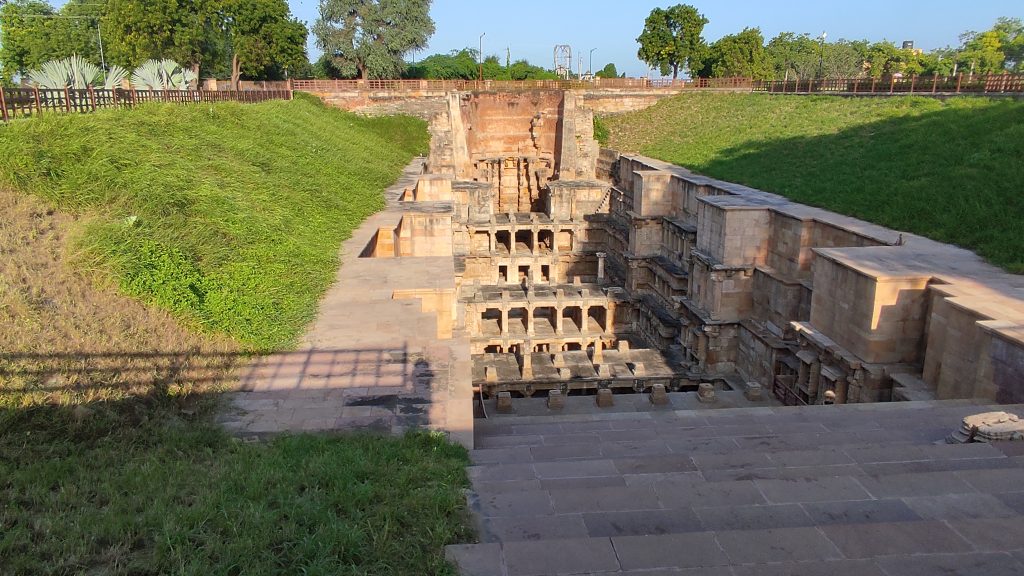
The Archaeological Survey of India started excavations here in 1958. The painstaking efforts of ASI exposed the hidden treasures of structural, cultural and architectural wealth in its original dimension and splendour through careful excavation, desilting and removal of debris. The loose sculptures, architectural members and stones fallen in the wall were lifted out carefully and set right in their position. Some supports were added and reconstruction done to match the original. Befitting its name the Rani Ki Vav is now considered to be the queen among the stepwells of India. 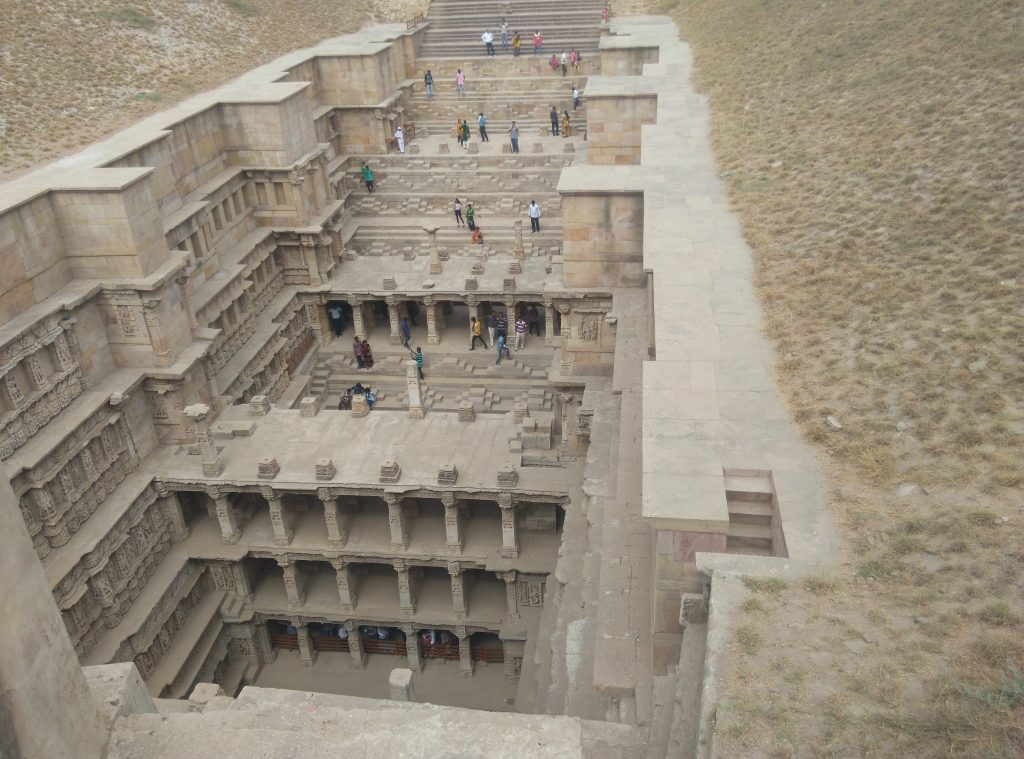
This magnificent step well is said to have been constructed by Rani Udaymati the queen of Bheemdeva Solanki 1, in his memory, in the last quarter of 11th century A.D. It is situated on the left bank of the river Sarasvati, two kms. North- west of Patan. Patan was the capital of Gujarat for over 600 years between 8th and 14th centuries under the reign of Solanki rulers Bheemdeva, his son Karan Deva and grandson Siddha Raja. At the time, Gujarat attained its greatest splendour and prosperity which is apparent from structural remains of temples, wells and tanks.
Rani Ki Vav is just beside the ancient fortification wall of the old city and not far from the embankment of Sahastraling talaav which was excavated much later, under the command of Siddhraj Jayasimha of 11th and 12th century. Which was another huge water tank to store surplus water. Unfortunately nothing much of the original remains now. 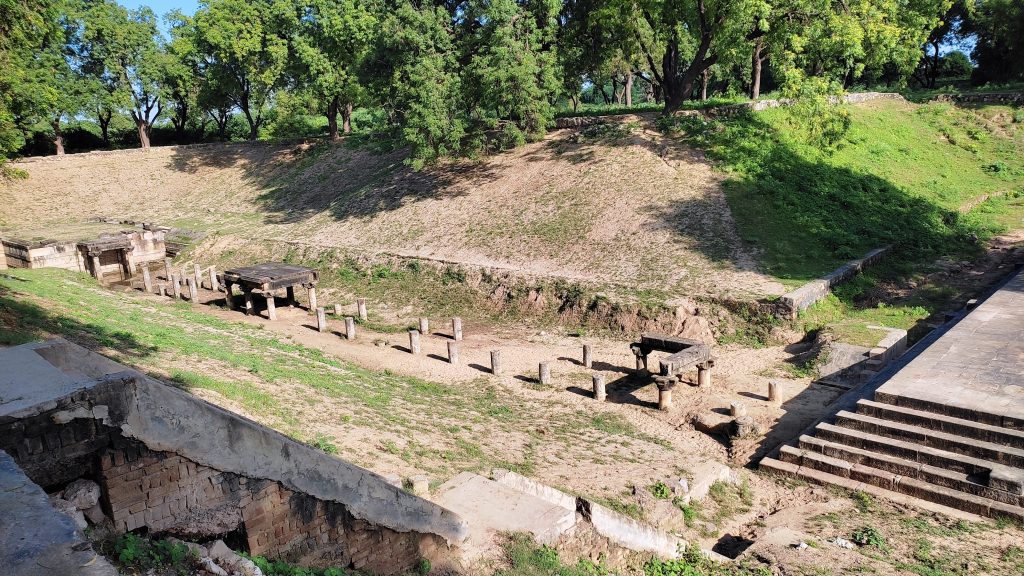
Rani Ki Vav is built up of bricks faced with stones. It has stepped corridors at the ground level and leading down to the kund. The main components of this well are the entrance, the side walls of the step corridors, mandapas or multi-storeyed pillared pavilions and the back walls of the well. Each storey has its roof supported on pillars with a square base decorated with ghat pallav motives and quadruple brackets at the top having four armed kichakas.
The walls flanking the staircase and sculptures within the walls of the well portray the mastery of the Solanki cutters in depicting rhythm, vigour, beauty and various moods in stone. The shaft of the well is highly ornamented with intricate carvings and large vertical brackets in pairs which support the different galleries of the well. Being a water edifice representation of Sheshsayi Vishnu in the shaft of a well at various levels is unique.
The Vav measuring about 64 m long and 20 m wide and 27 m deep is laid out in the east-west direction. It must have been one of the largest and the most admired structures of its kind at that time and still is. It is featured on our Indian currency note of Rs. 100/-
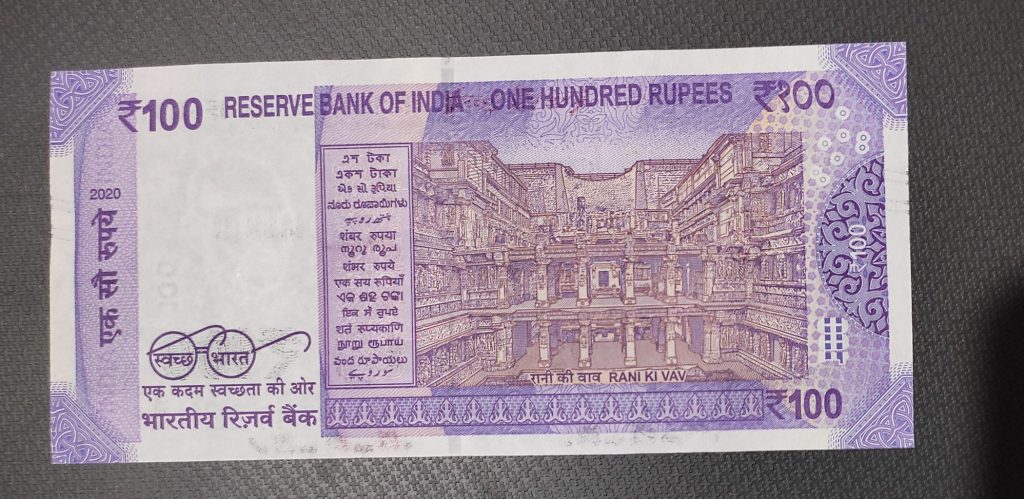
The architectural brilliance and elegance of the Vav is represented in its pristine glory in the ornamental work of the beautifully proportioned sculptures of gracefully curved Mahisasurmadini, Parvati and other Shaiva sculptures. The Dashavatars of Vishnu such as Varah, Vamana, Rama, Buddha and Kalki, Bhairava, Ganesha, Surya, Kubera, Lakshmi-Narayan, Ashta-dikpalas, Apsaras, Nagkanayas, Yogini etc. which adorn the walls. The female figures have been depicted in various poses with extreme beauty and grace. The carvings and their subjects are very much similar to the work at Modhera and other places, as they were patronized by the same family and built almost simultaneously. 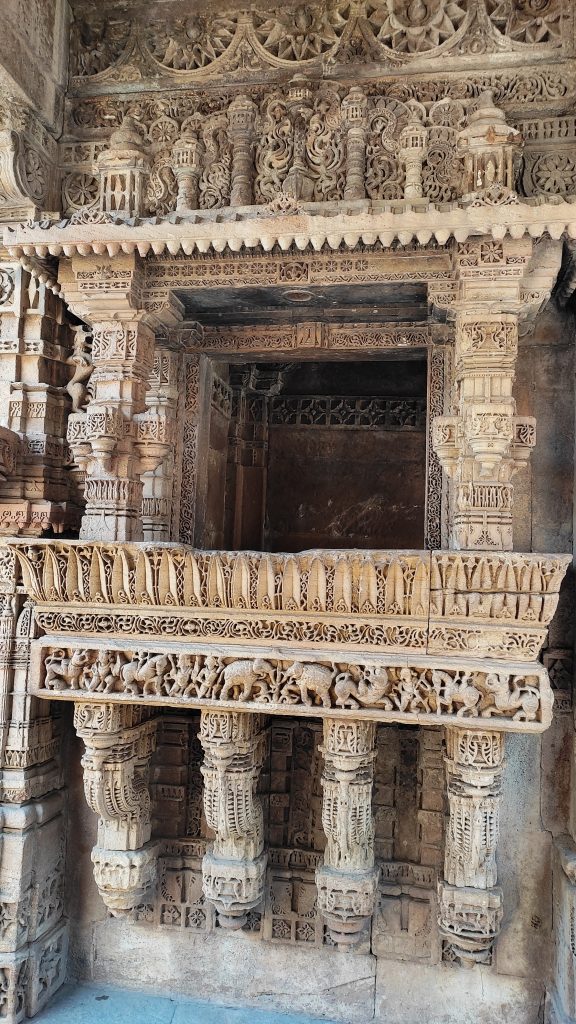
The well had been visited by British travellers in the first half of the 19th century. Henry Cousens and James Burgess who visited the stepwell at Patan in 1886 and found that the well was completely filled up with earth and only the back wall of the well and pillars of Toran were visible. An early account is found in James Tod’s travels in Western India stating that materials of this well were used in building another well in Patan known as Barot Ni Vav.
MODHERA – THE SUN TEMPLE
Modhera is situated 75 km to the northwest of Ahmedabad and 35 km from Mehsana in North Gujarat. The old Solanki capital of Patan is situated 40 km to the north of Modhera this is an ancient township referred to in The Puranas as Dharma Yana.
The Sun Temple Modhera is located on the left bank of the river Pushmaavati,
a tributary of River Rupan in Bechraji Taluka of Mehsana District. The literal meaning of Modhera is Mount of the Dead. Modhera is sometimes called ‘Mundera’ the original settlement of the Modha Brahmins. For air travellers Ahmedabad is a convenient option to reach Modhera.
This Temple ranks next only to the Sun Temple of Konark and is one of the finest examples of temple architecture in Gujarat. It is built on a platform facing east. Archaeologists found a stone inscribed with Vikram Sawant 1083 which corresponds to 1026 1027 A.D., during the reign of Solanki King Bheemdeva I. The date of erection is almost 1000 years old. Modhera’s grandeur was first described by the British archaeologists James Burgess and Henry Cousens in the early 20th century. 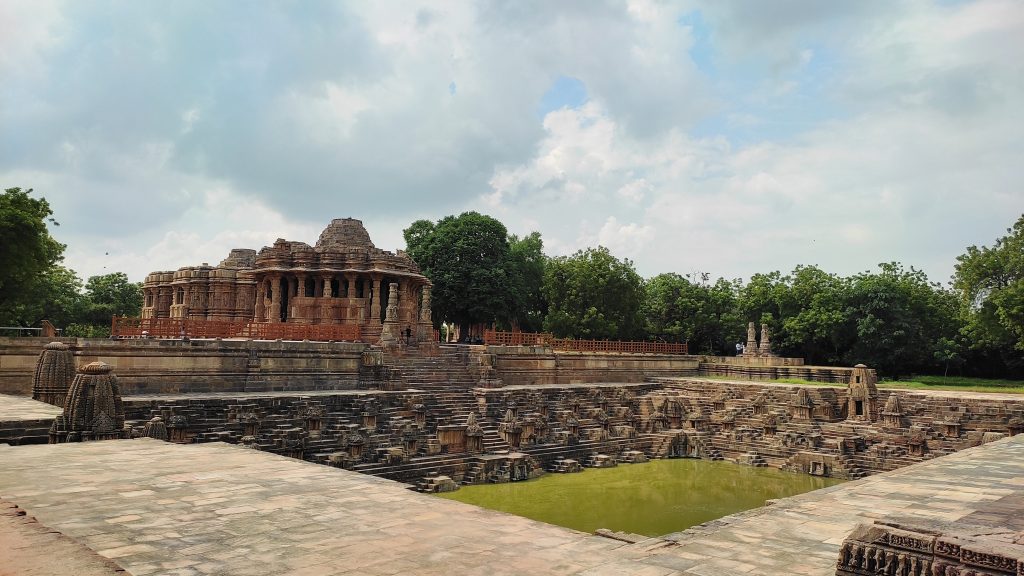
The temple consists of three separate elements: The main temple-complex, including sanctum (Gudha Mandap) lateral transepts and porch. Second is a detached assembly hall (Sabha Mandapa or Nritya Mandapa) with a torana in front and third, a large rectangular masonry tank 175 by 120 ft decorated with numerous miniature shrines. Locally known as Ramakunda, approached through a grand flight of steps from all four sides. The tank has about 108 small temples which contain the relief of various deities.
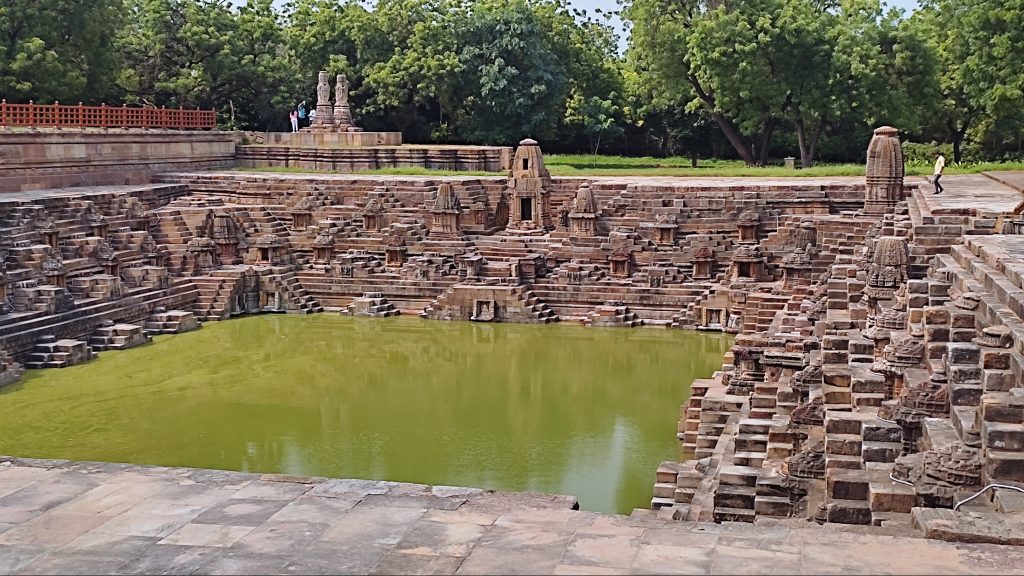
The sanctum has an arrangement of elegantly decorated pillars with exquisite ornamentation. The outer walls of the Sanctum are relieved by niches containing the images of 12 Adityas, (Aditya is another name for the Sun) panels of Ashta-Dikpalas, different forms of Gauri, dancing Apsaras, musicians etc. (The dikpalas in Hinduism are guardian gods presiding over the directions of space. The eight dikpalas are as follows: East is Indira, South East = Agni, South = Yama, West = Varuna, South West = Nirrti, North = Kubera, North West = Vayu and North East = Ishan. ) The outer walls are extensively decorated with images of various forms of Gods. The inner walls are decorated with sculptures and scenes depicted from Ramayana and Mahabharata.
There are 12 manifestations corresponding to the cycle of 12 months in a year which have been depicted here and worshipped since Vedic Times. Lord Surya stands in samabhanga pose in a chariot drawn by 7 horses with two full blown Lotus flowers held in each hand.
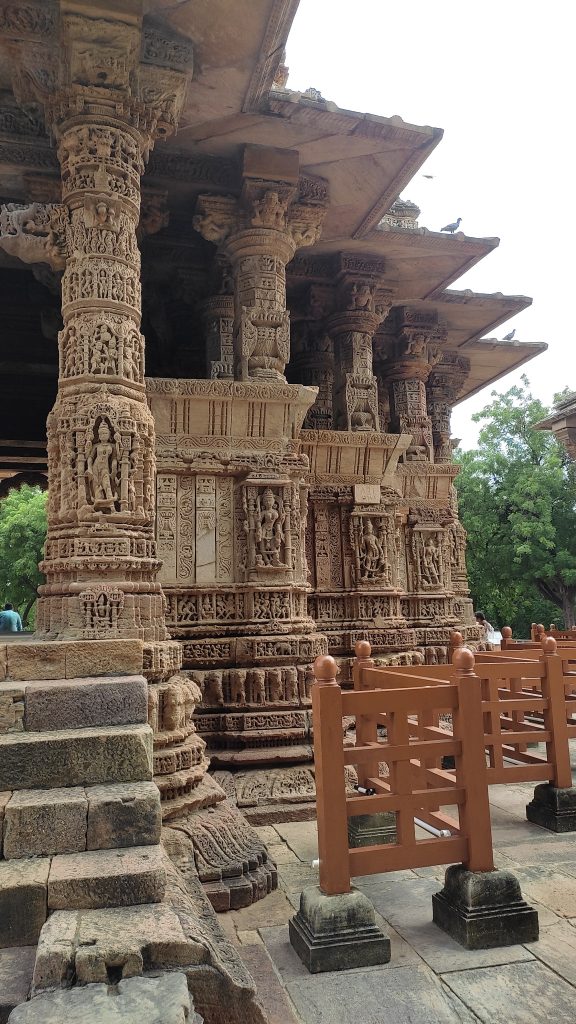
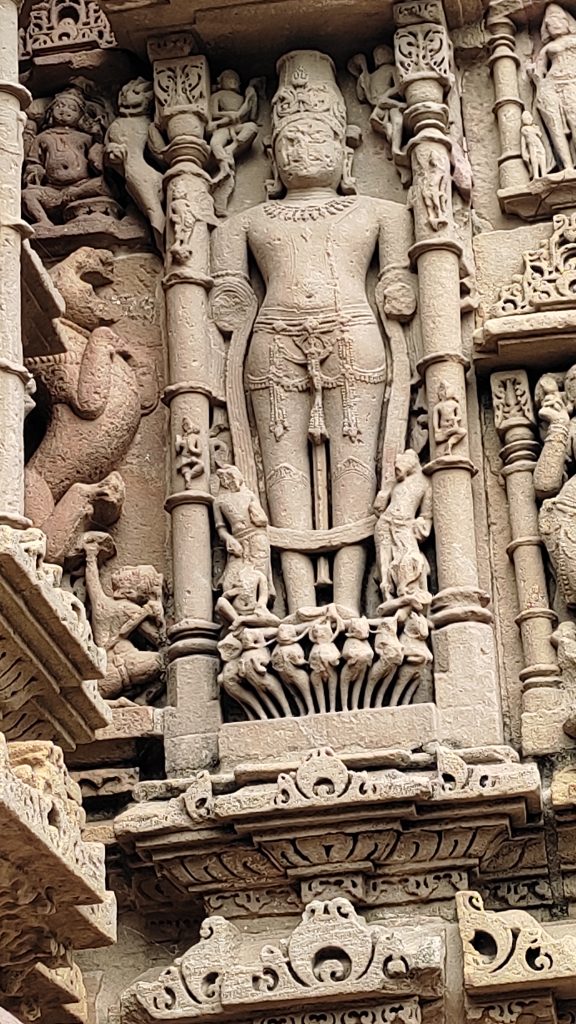
Most of the sculptures at Modhera belong to the post Gupta period and they represent both Shavite and Vaishnav sects. The sculptures include Brahma, Sheshashayi Vishnu, and Vishnu in various incarnations like Varah, Trivikram, Narasimha, Krishna and Sudama. Some of the sculptures representing Shiva are Uma Maheshwara, Shakti, Ganesha, Nritya Ganesha, Saptha Matrikas, Durga, Parvati, Shitala Mata and several other mother Goddesses and dancing Apsaras like Lilavati, Shubhangini, Hansawali, Padmini, Mrigashi, Bhav, Chandra.
The Ranga Mandap is an open pillar hall and must have been the place for religious congregation, singing and dancing its form is strikingly different from that of the closed hall of the main shrine. The Rang Mandap is fronted by a deep and huge tank, fed by subsoil water of the Pushmaavati River nearby. Its design is aesthetically pleasing. The entire descent is divided into four terraces with steps in the form of truncated pyramids introduced at regular intervals, forming a pleasing geometric pattern (which also forms the basic design of the weaves of Patan Na Patola.
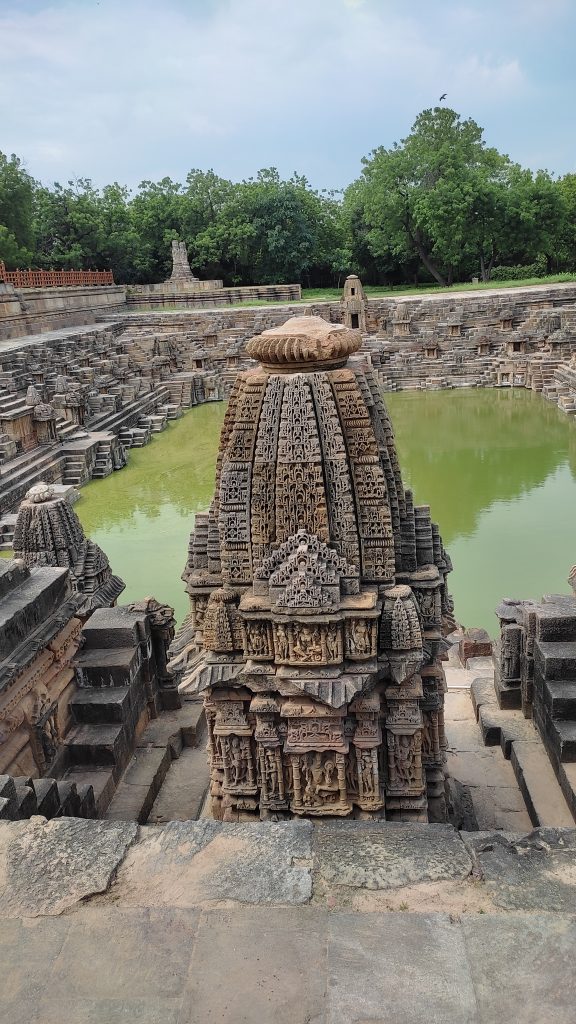
This temple is one of the remarkable gems of temple architecture in the country and the pride of Gujarat. It has been designed to allow the first rays of the sun to fall on the image of Surya the Sun God at the time of the equinox.
Between the kund and the Rang Mandapam there is an imposing ceremonial free standing gate (Toran). Such free standing gates were often erected in front of temples in Western India. The design consists of two tall columns divided into many horizontal and vertical bands decorated with ornate figures, animals etc., ornate beams and other architectural members. Here at Modhera the Toran has been partially preserved.
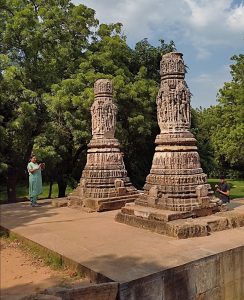 Every year a Dance Festival is held here in the month of January to honour the Sun God. During this festive occasion the temple is illuminated at night. High quality sound systems and excellent lighting provide an ideal setting for visitors to enjoy the dance. The festival is a great attraction, with internationally acclaimed artists performing in front of the temple.
Every year a Dance Festival is held here in the month of January to honour the Sun God. During this festive occasion the temple is illuminated at night. High quality sound systems and excellent lighting provide an ideal setting for visitors to enjoy the dance. The festival is a great attraction, with internationally acclaimed artists performing in front of the temple.
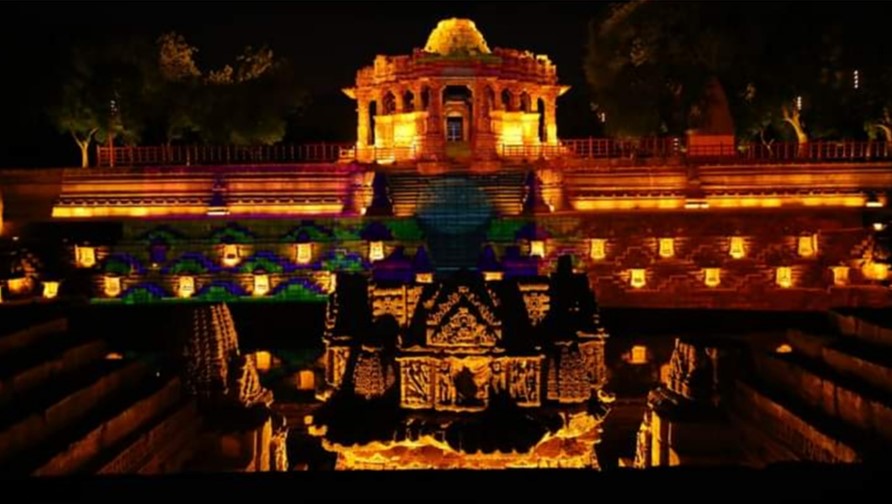
There has been an attempt by the state government to make Modhera a model town which is fully powered by solar energy and in 2022 this has been achieved. Hence Modhera became the first town in the country to be 100% solar dependent.
Another interesting observation was that near the temple information about the temple structure is also displayed in Braille, to help visually impaired visitors. A fantastic initiative.
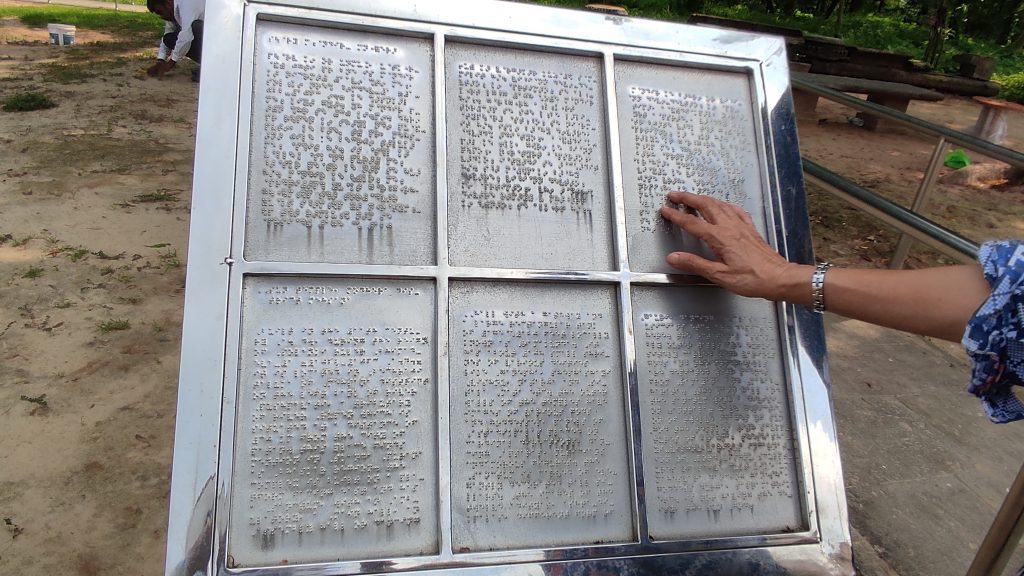
RUDRABAI or THE ADALAJ STEPWELL
Adalaj lies on the outskirts of Gandhinagar, Ahmedabad in Mehsana district of North Gujarat. It can be easily visited if you happen to be in Ahmedabad even for a short trip. The history of this stepwell was established with the help of a Sanskrit inscription written in devnagri script found on a marble slab. It says samvat 155 that is 1498 AD.
Built in 1499 by the wife of the Vaghela King Rana Veersinh, Rudrabai. Hence it is also known as Rudrabai Step well. The Rana started this construction in 1498 for his beautiful wife, but he was killed in war by the Muslim King Muhammad and the VAV was left incomplete. Legend has it that the Muslim king then convinced the widowed Rudrabai to marry him, with a promise to complete the well. After the well was completed the saddened queen jumped into this well and committed suicide.
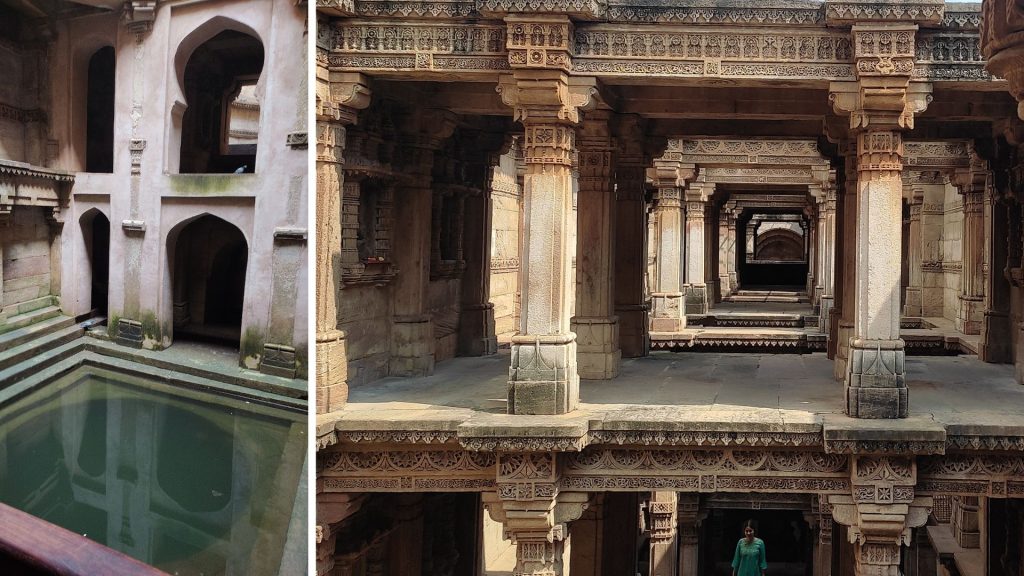
It is five storeys deep with beautiful carvings of deities and floral patterns. The well is unique for its Indo-Islamic architecture style with intricate floral designs, merging gracefully with Hindu and Jain symbols. IMAGES 14 & 15
Some other well-known step wells:
RAMAKUND STEP WELL – BHUJ
This one is believed to exist from the time of Ramayana and Mahabharata. It is surrounded by sculptures of characters of Lord Ram, Sita, Lakshman and Hanuman. It also has sculptures of the ten incarnations of Lord Vishnu.
ADI KADI VAV – JUNAGADH
This is a 15th Century step well, carved out of sheer hard rock. 120 steps cut in stone, in a lean path to go down to the water level. There are no sculptures or embellishments here.
THE NAVLAKHI VAV – BARODA
Another 15th century step well exists in the heart of Baroda (now Vadodara.) It is believed that nine lakh gold coins were spent on the construction
of this stunning structure, hence the name Navlakhi. It was built to supply water to the city, later used for the construction of Laxmi Vilas Palace and now the water from this is used to irrigate the Gaekwad Baroda Golf Course which is adjacent to it.
There is another stepwell at Sevasi, on the outskirts of Vadodara city, but it is lying in a neglected condition.
HELICAL STEPWELL – CHAMPANER (NEAR VADODARA)
This one is made in the 16th century. It has a spiral stairway going down, made of rock, while the walls are made of bricks. It is unique because of its circular structure.
DADA HARIR NI VAV – ASARVA
It is an octagon shaped step well, also in the vicinity of Ahmedabad’s Asarva area. It was built over 500 years ago during the time of Sultan Mahmud Begda. This seven story structure has beautifully carved intricate designs with a combination of Hindu and Muslim architecture and motifs and inscriptions from Arabic and Sanskrit scriptures. It was built by Bai Harir Sultani, a lady from Begda’s household.
More step wells from the Solanki (Chaulukya) Period. Most of them are however credited to Rani Minaldevi, the mother of Raja Jayasimha Siddharaja Solanki, and built in the 3rd quarter of the 11th century A.D.
MATA BHAWANI’S STEP WELL – AHMEDABAD
ANKOL MATA STEP WELL – DAVAD
MINALDEVI VAV – VIRPUR
Interestingly rainwater harvesting was done at a domestic level in Gujarat.
In earlier times every individual home had its own underground water reservoir under the living area called TANKO. Now that there is drinking water available around the year provided by the local corporations all year round, this practice of keeping such a provision is vanishing. In fact the older houses which still have a chamber have been filled up after suffering damages due to earthquakes in the recent past.
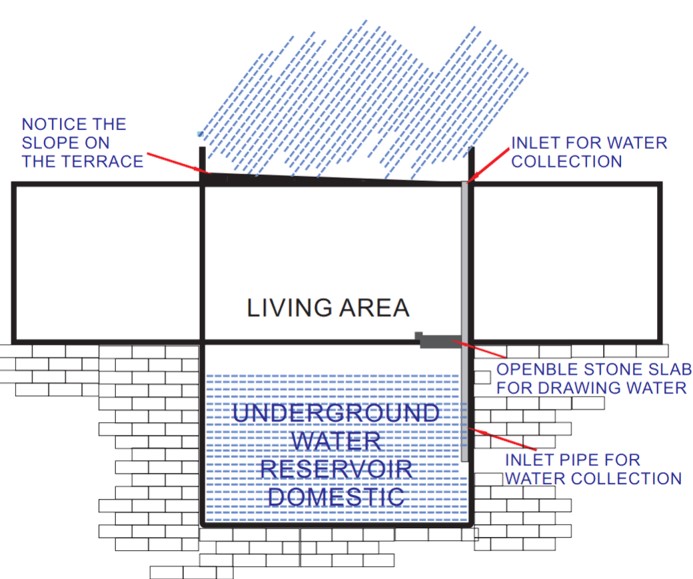
The cross section of these houses was somewhat like this. The collected rainwater also kept the living area cool during the daytime heat. It kept the house cool, as in those days people slept on the floor in the chowk of the living area. There was an opening covered with a flat stone through which the water could be drawn much like drawing water from a well with a bucket, as there were no motors for the purpose. This was common practice. Cloth was tied at the mouth of the collection pipe and entrance to the tank to remove any physical impurities. This opening was also used to clean the tank periodically before the onset of monsoon.








